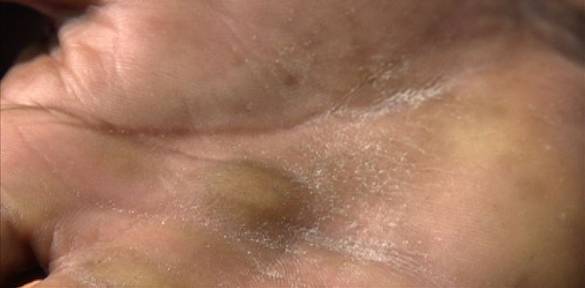ADVERTISEMENT
Filtered By: Publicaffairs
Public Affairs
Kalyo 101: Pinoy MD's guide to calluses

"Pakiramdam ko sa mga daliri ko matitigas na eh. Sabi nga 'pag sinampal mo sa tao 'yan wala na. Hindi na makaganti,"
In an interview with GMA-7’s Pinoy MD, Rudy Gustoer laments about the thick calluses on his hands. He works as a construction worker whose tasks involve lifting hollow blocks and shoveling sand regularly. "Kahit anong hawakan kong mabibigat, wala nang pakiramdam. Parang manhid na," he said.
But more than being a result of hard work and labor, having calluses is actually a sign that you're not giving your hands and feet the care they deserve.
Having calluses, or kalyo in Tagalog, is a result of hyperkeratosis, a process in which skin becomes thick and hard. It is often caused by the constant friction and pressure that our hands and feet encounter regularly.
Dr. Grace Beltran, a dermatologist from St. Luke's Medical Center, assured that calluses do not have harmful effects as long as the stay clean and infection-free. "Kasi kung minsan, kung saan 'yung kalyo doon nagkakaroon ng verruca, o kulugo. Kung minsan naman kung laging natatapakan at nasusugatan, pwedeng magkaroon ng pigsa doon sa kalyo na 'yun."
A regular foot spa session could cost up to P300 while a surgery that removes calluses could cost up to P2,500. Luckily, for those who do not have the time or the money to spare for these treatments, there are some alternatives:
Homemade kalyo remover for your feet
You will need:
2 pieces pan de sal
1/2 cup vinegar
Gauze or old cloth
Coconut milk
3 to 5 tablespoons baking soda
Slice the pan de sal in half. Soak the sliced pan de sal bun into the vinegar for at least 15 seconds or until the bread absorbs all the liquid. Put the soaked bun on the area where you have calluses. Secure the bun in place by wrapping gauze or a clean piece of cloth around it.
After 10 minutes, remove the bun and use a stone scrub to rub the callused skin off your feet. To keep your skin soft and moisturized, use coconut milk to rinse your feet.
Naturopathy and alternative medicine practitioner Vivian Mix, N.P. explained that this method is an effective way of softening hard and thick calluses. "May enzyme yan eh. Kakainin noon 'yung balat na matigas na."
Another method is to use baking soda. Put 3 to 5 tablespoons of baking soda in a basin of warm water. Soak and massage feet for at least 10 minutes. Pat your feet dry before using a stone scrub to remove the callus off.
Homemade kalyo remover for your hands


You will need:
Pineapple skin
Bandage
Simply rub the pineapple skin over the callused parts of your hands. Natural enzymes from the pineapple will help soften your skin. After this, use a nail file to scrub the softened skin off.
"The best is 10 minutes or more," said Mix. "I recommend kapag may time sila, it's better everyday or every other day. Kapag wala ka namang time, twice a week, okay na."
Kalyo Do's and Dont's
To prevent calluses from getting worse, wrap a bandage around areas prone to friction. You can also apply virgin coconut oil to your feet before wearing shoes.
Remember to choose comfortable footwear. It is also advisable to use different kinds of shoes everyday so that your feet will not be exposed to the same friction and pressure caused by a pair for too long.
Dr. Beltran also advises against using blades and knives to remove calluses since contaminated and unsterilized objects can cause infections.
Pinoy MD airs every Saturdays at 6 AM on GMA. For more information, check out our official Facebook and Twitter accounts. – Lara Gonzales/ARP, GMA News
Related "Pinoy MD" articles:
Tags: webexclusive
More Videos
Most Popular




